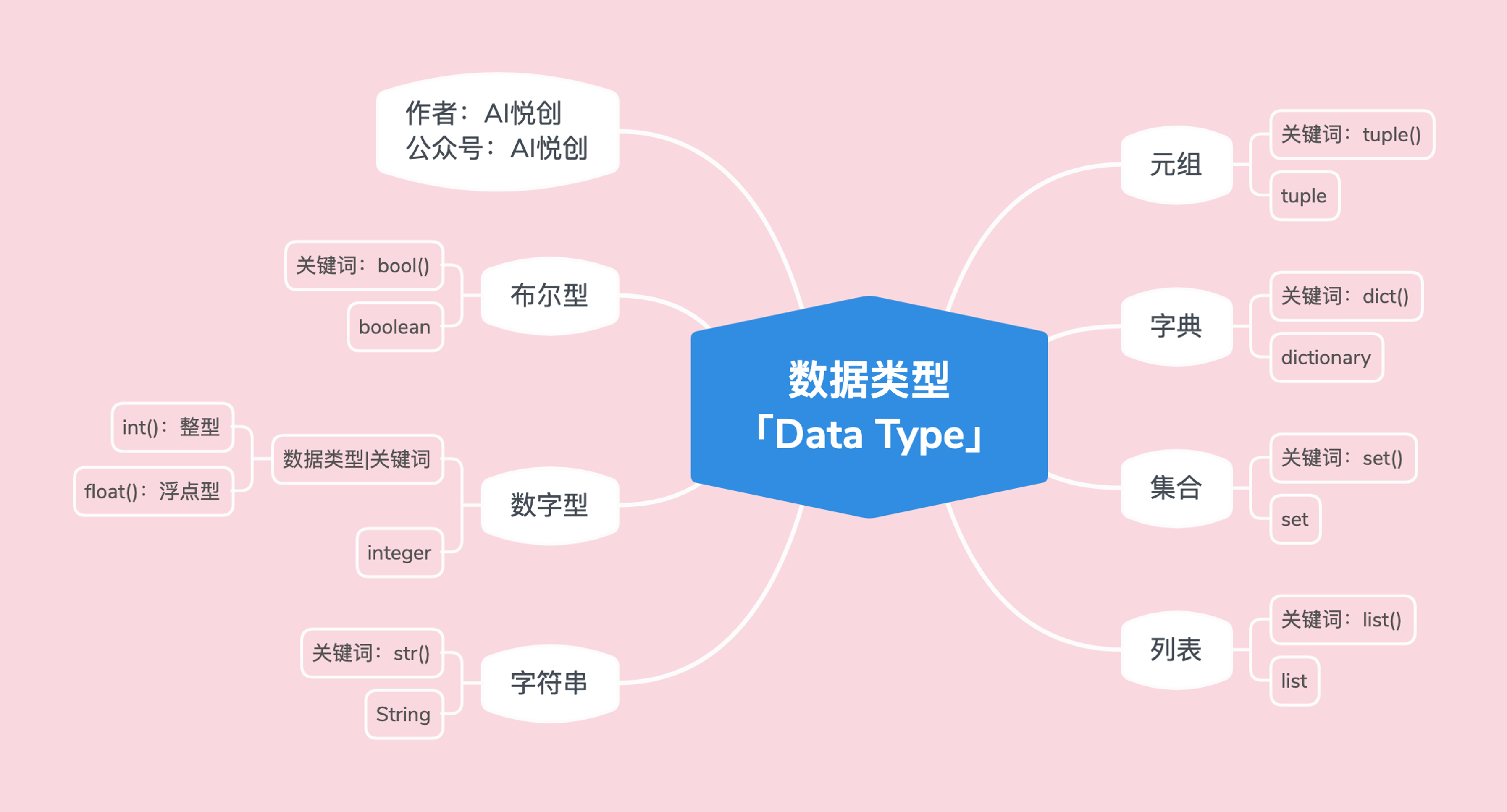01-初探 Python 数据类型
原创2023/2/2大约 3 分钟...约 818 字
1. 一图胜千言

2. 数字型
2.1 整型「int」
x = 1
# 检测数据类型方法一
t = type(x)
print(t)
# 检测数据类型方法二
print(type(x))
# ------output------
<class 'int'>
<class 'int'>2.2 浮点型「float」
3. 字符串「str」
4. 列表「list」
5. 元组「tuple」
6. 字典「dict」
字典是由一系列的 key 与 value 组成的,d = {key1: value1, key2: value2}。我们可以创建如下字典:
d1 = {"name": "bornforthis", "age": 18, "gender": "F"}
d2 = {1: "number", (1, 2, 3): "tuple", True: "bool"}
# 检测数据类型
d1_type = type(d1)
d2_type = type(d2)
print("d1_type:", d1_type)
print("d2_type:", d2_type)
print(d1)
print(d2)
# ------output------
d1_type: <class 'dict'>
d2_type: <class 'dict'>
{'name': 'bornforthis', 'age': 18, 'gender': 'F'}
{1: 'bool', (1, 2, 3): 'tuple'}6.1 字典创建规则
- key:字典中,key 需使用不可变的数据类型。如果使用可变数据类型,将会报错:
TypeError: unhashable type: 'list'- 列表、字典、集合皆不能做字典的 key
- value:任意数据类型
代码
d3 = {[1, 2, 3]: "number"}
print(d3)报错输出
Traceback (most recent call last):
File "/Users/huangjiabao/GitHub/SourceCode/MacBookPro16-Code/PythonCoder/StudentCoder/15-WUlili/lesson01/demo.py", line 8, in <module>
d3 = {[1, 2, 3]: "number"}
TypeError: unhashable type: 'list'6.2 字典的特性:
- 字典是一系列由键(key)和值(value)配对组成的元素的集合;
- 在 Python3.7+,字典被确定为有序(注意:在 3.6 中,字典有序是一个 implementation detail,在 3.7 才正式成为语言特性,因此 3.6 中无法 100% 确保其有序性),而 3.6 之前是无序的;
- 字典长度大小可变,元素可以任意地删减和改变。
提示
字典有序性和以往(列表、字符串、元组等)有序性不同。零基础小白,前期理解为无序即可。「因为,你目前用不到此特性」
7. 集合「set」
set1 = {1, 2, 3, "aiyc", (1, 2, 3), True, False, 1.1}
print(type(set1))
print(set1)
# ------output------
<class 'set'>
{False, 1, 2, 3, 1.1, 'aiyc', (1, 2, 3)}7.1 集合的特性
- 确定性:每一个值都必须是确定的
- 无序性:没有顺序
- 互异性:不能相同,相同的会自动去除「去重」
集合确定性解析
集合确定性解析
列表可变,所以导致列表不确定。
举个例子🌰:
- 在 1s 的时,列表数据为:
lst = [1, 2, 3]; - 在 1.6s 时,列表数据为:
lst = [1, 2];
那我们是否可以说:我确定,列表数据一直都是 [1, 2, 3] 。——这句话显然是不合理。
集合无序性解析
集合无序性解析
set1 = {1, 2, 3, "aiyc", (1, 2, 3), True, False, 1.1}
print(set1)
# ------output------
{False, 1, 2, 3, 1.1, 'aiyc', (1, 2, 3)}有可能你运行多次结果一样,但集合就是无序性。例如:你抛骰子或者硬币,你一直得到骰子6或者硬币上,真的就说抛骰子或者硬币就是确定的吗?
集合互异性解析
集合互异性解析
set1 = {1, 2, 3, 1, 1, 1, 1, 1, 1, 1}
print(set1)
# ------output------
{1, 2, 3}8. 布尔型「bool」
a = True
b = False
print(type(a))
print(type(b))
print(a)
print(b)
# ------output------
<class 'bool'>
<class 'bool'>
True
False更新日志
2025/4/11 07:49
查看所有更新日志
1c35a-于aed17-于772c4-于65bb5-于e6a0f-于
贡献者
AI悦创AndersonHJB